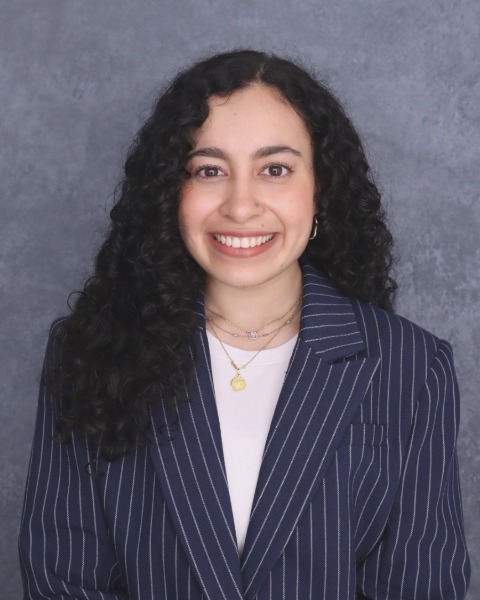Tuesday Poster Session
Category: Colorectal Cancer Prevention
P4818 - Virtual Reality as a Non-Pharmacologic Adjunct for Pain and Anxiety During an Unsedated Colonoscopy: Case Report
Tuesday, October 28, 2025
10:30 AM - 4:00 PM PDT
Location: Exhibit Hall

Muskaan R. Mehra, MS (she/her/hers)
Cedars-Sinai Medical Center
Los Angeles, CA
Presenting Author(s)
Muskaan R. Mehra, MS, Ella Tetrault, BS, Rajsavi Anand, MD, Kavya Reddy, MD, Brennan Spiegel, MD, MSHS
Cedars-Sinai Medical Center, Los Angeles, CA
Introduction: Colorectal cancer is the second leading cause of cancer-related deaths in the United States. Colonoscopy is the gold-standard and most common procedure for colorectal cancer (CRC) screening, often performed under sedation to enhance patient comfort. However, sedation poses risks and requires post-procedural assistance, limiting access for individuals without transportation, social support, or with anesthesia contraindications. Virtual Reality (VR) is a promising non-pharmacological tool for managing procedural pain and anxiety. We present a case demonstrating successful use of VR to facilitate unsedated colonoscopy in a patient with medical comorbidities and logistical barriers to sedation.
Case Description/
Methods: A 77-year-old female with a history of breast cancer s/p lumpectomy and radiation therapy, obstructive sleep apnea, and hypertension presented for a routine surveillance colonoscopy given history of tubular adenomas. Lacking post-procedure transportation, she opted for an unsedated procedure, which revealed a fixed, angulated, and tortuous sigmoid colon with severe diverticulosis. Despite using the water immersion technique, the patient showed signs of distress, physical tension and discomfort, resulting in a challenging procedure. To improve tolerability, a VR headset displaying a calming lakeside sunset scene with soothing audio (Figure 1) was introduced mid-procedure. Upon use, the patient reported complete pain relief and showed visible relaxation, allowing the procedure to continue smoothly. Two polyps were removed with cold snare and forceps polypectomy. Pathology revealed 1 sessile serrated polyp and 1 tubular adenoma. Post-procedurally, the patient expressed high satisfaction and willingness to repeat a colonoscopy with VR.
Discussion: This case study highlights VR as a safe, non-pharmacologic, non-invasive tool for managing pain and anxiety during medical procedures when sedation is not feasible. VR acts as an immersive distraction tool, redirecting attention away from noxious stimuli by engaging multisensory input. The patient displayed both subjective (verbal reports of “no pain”) and objective (muscle relaxation) signs of relief, allowing scope advancement despite complex anatomy. This case illustrates that VR can support unsedated colonoscopy as a viable, well-tolerated option, even in complex cases, enhancing access and procedural efficiency. Further research is warranted to assess VR’s broader clinical use.
The authors used ChatGPT solely to reword and rephrase text.

Figure: Virtual Reality Landscape of the Serene Lakeside Scene During Sunset Seen by the Patient During the Unsedated Colonoscopy.
Disclosures:
Muskaan Mehra indicated no relevant financial relationships.
Ella Tetrault indicated no relevant financial relationships.
Rajsavi Anand indicated no relevant financial relationships.
Kavya Reddy indicated no relevant financial relationships.
Brennan Spiegel: Exact Sciences – Consultant. Freenome – Consultant. Guardant Health – Consultant.
Muskaan R. Mehra, MS, Ella Tetrault, BS, Rajsavi Anand, MD, Kavya Reddy, MD, Brennan Spiegel, MD, MSHS. P4818 - Virtual Reality as a Non-Pharmacologic Adjunct for Pain and Anxiety During an Unsedated Colonoscopy: Case Report, ACG 2025 Annual Scientific Meeting Abstracts. Phoenix, AZ: American College of Gastroenterology.
Cedars-Sinai Medical Center, Los Angeles, CA
Introduction: Colorectal cancer is the second leading cause of cancer-related deaths in the United States. Colonoscopy is the gold-standard and most common procedure for colorectal cancer (CRC) screening, often performed under sedation to enhance patient comfort. However, sedation poses risks and requires post-procedural assistance, limiting access for individuals without transportation, social support, or with anesthesia contraindications. Virtual Reality (VR) is a promising non-pharmacological tool for managing procedural pain and anxiety. We present a case demonstrating successful use of VR to facilitate unsedated colonoscopy in a patient with medical comorbidities and logistical barriers to sedation.
Case Description/
Methods: A 77-year-old female with a history of breast cancer s/p lumpectomy and radiation therapy, obstructive sleep apnea, and hypertension presented for a routine surveillance colonoscopy given history of tubular adenomas. Lacking post-procedure transportation, she opted for an unsedated procedure, which revealed a fixed, angulated, and tortuous sigmoid colon with severe diverticulosis. Despite using the water immersion technique, the patient showed signs of distress, physical tension and discomfort, resulting in a challenging procedure. To improve tolerability, a VR headset displaying a calming lakeside sunset scene with soothing audio (Figure 1) was introduced mid-procedure. Upon use, the patient reported complete pain relief and showed visible relaxation, allowing the procedure to continue smoothly. Two polyps were removed with cold snare and forceps polypectomy. Pathology revealed 1 sessile serrated polyp and 1 tubular adenoma. Post-procedurally, the patient expressed high satisfaction and willingness to repeat a colonoscopy with VR.
Discussion: This case study highlights VR as a safe, non-pharmacologic, non-invasive tool for managing pain and anxiety during medical procedures when sedation is not feasible. VR acts as an immersive distraction tool, redirecting attention away from noxious stimuli by engaging multisensory input. The patient displayed both subjective (verbal reports of “no pain”) and objective (muscle relaxation) signs of relief, allowing scope advancement despite complex anatomy. This case illustrates that VR can support unsedated colonoscopy as a viable, well-tolerated option, even in complex cases, enhancing access and procedural efficiency. Further research is warranted to assess VR’s broader clinical use.
The authors used ChatGPT solely to reword and rephrase text.

Figure: Virtual Reality Landscape of the Serene Lakeside Scene During Sunset Seen by the Patient During the Unsedated Colonoscopy.
Disclosures:
Muskaan Mehra indicated no relevant financial relationships.
Ella Tetrault indicated no relevant financial relationships.
Rajsavi Anand indicated no relevant financial relationships.
Kavya Reddy indicated no relevant financial relationships.
Brennan Spiegel: Exact Sciences – Consultant. Freenome – Consultant. Guardant Health – Consultant.
Muskaan R. Mehra, MS, Ella Tetrault, BS, Rajsavi Anand, MD, Kavya Reddy, MD, Brennan Spiegel, MD, MSHS. P4818 - Virtual Reality as a Non-Pharmacologic Adjunct for Pain and Anxiety During an Unsedated Colonoscopy: Case Report, ACG 2025 Annual Scientific Meeting Abstracts. Phoenix, AZ: American College of Gastroenterology.
